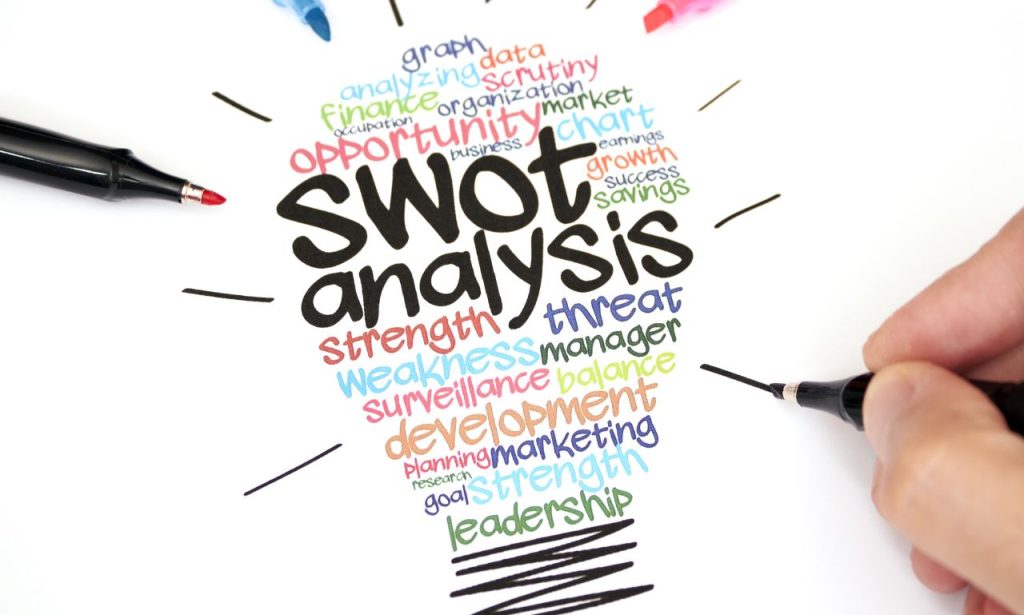Navigating the complex world of business means understanding your position clearly—and there’s no better way than using SWOT analysis. So, what are the four parts of SWOT analysis? We’re diving right into Strengths, Weaknesses, Opportunities, and Threats, each offering a lens to view and enhance your strategy.
Let’s break it down and discover why SWOT analysis remains the powerful tool every savvy business owner relies on.
Understanding SWOT Analysis
SWOT Analysis is a strategic planning tool that helps businesses evaluate their internal factors and external environment to craft winning strategies. With SWOT’s four parts—Strengths, Weaknesses, Opportunities, Threats—you’ll dive deep into internal strengths, identify external threats, and leverage external opportunities to get a competitive edge. Here’s the blueprint.
What Are the Four Parts of SWOT Analysis?

- Strengths
- Weaknesses
- Opportunities
- Threats
Each of these four sections is essential in analyzing a company’s current position, whether to grow, pivot, or identify gaps. Let’s explore each part of SWOT analysis, its nuances, and how to use them for business success.
Strengths
Definition and Importance
Strengths are your internal attributes that give your business an upper hand in the competitive landscape. It could be your loyal customer base, a proprietary technology, or even your cutting-edge technologies. Strengths are your ace up the sleeve—the things you do better than anyone else.
Strengths can stem from multiple areas of your business, including brand loyalty, financial stability, intellectual property, and business processes that are more efficient than your competitors’. Identifying these strengths is crucial to maximizing their impact and positioning your company effectively in the marketplace.
Why Identifying Strengths Matters
- Helps focus on competitive advantage.
- Enables the business to leverage internal strengths to enhance market position.
- Facilitates the strategic planning process by clarifying where you excel.
- Highlights internal strengths that are worth investing more time and resources into.
Strengths allow you to double down on what makes you different, what makes you valuable, and what your customers love about you. Whether it’s a product feature, a unique capability, or unmatched customer service, strengths play a key role in helping a business succeed.
Identifying Your Organization’s Strengths
How do you pinpoint your company’s internal strengths? Here are some thought starters:
- Technical expertise in a particular area that distinguishes you from competitors.
- Positive aspects of your company culture, like employee satisfaction or collaborative environment.
- Your loyal customer base that keeps coming back.
- Having a skilled workforce with the right mix of experience and talent.
- A strong market position in your target market that competitors struggle to match.
- Access to financial resources that allow you to seize opportunities quickly.
- An innovative product development team that consistently delivers high-quality new features or products.
Strengths go beyond just products or services—they include anything that enhances your business performance, efficiency, or reputation.
Examples of Strengths
- Efficient processes that save time and cost, providing a clear competitive edge.
- Strong brand recognition in a competitive market that makes it easier to retain and attract customers.
- High customer loyalty and customer satisfaction, which serve as a foundation for referrals and repeat business.
- Access to financial resources that offer a buffer in terms of growth plans and flexibility in making strategic investments.
- Advanced supply chain technologies that create an advantage over competitors, resulting in faster delivery and higher reliability.
- Technical expertise that allows for custom product offerings tailored to customer preferences.
- Strong intellectual property that protects your innovations and creates a competitive advantage.
Weaknesses
Identifying Weaknesses
Weaknesses are those internal weaknesses that may hinder your progress or make you vulnerable in the competitive landscape. Recognizing weaknesses means being honest about areas needing improvement. Acknowledging these weaknesses provides insight into the areas that are holding your business back and allows you to develop a plan to address them.
Why Identifying Weaknesses Matters
- Provides opportunities to address weaknesses before they become significant issues.
- Helps refine your business processes for greater efficiency and improved outcomes.
- Assists in identifying areas where you need technical expertise or more qualified staff.
- Enables the creation of actionable steps to turn weaknesses into potential strengths.
A key part of improving your business is understanding where you fall short. Weaknesses can range from outdated technology to inefficient workflows or even a lack of brand recognition. By identifying weaknesses, you can work toward transforming them into strengths.
Identifying Your Organization’s Weaknesses
To identify weaknesses, think about the areas where your business struggles:
- Lack of technical expertise or innovation in crucial business areas.
- Outdated technology that limits your ability to compete effectively.
- Low employee morale or issues in company culture that result in high employee turnover.
- Resource hog activities that waste time and limit productivity.
- Limited market presence or difficulty gaining a foothold in new markets.
- Internal processes that are inefficient or cumbersome, leading to higher costs.
- Poor financial stability or lack of sufficient financial resources to invest in new initiatives.
- Lack of strategic partnerships that could help expand the reach or capabilities of your business.
Examples of Weaknesses
- Limited market presence compared to competitors with a broader reach.
- Outdated business processes that aren’t efficient, leading to lost opportunities and increased costs.
- Poor customer service, leading to loss of customer loyalty and negative reviews.
- Shortage of recruits or qualified staff with the expertise needed to grow the business.
- Lack of strategic initiatives for expansion or innovation, leading to missed opportunities.
- Financial instability that prevents you from investing in growth opportunities.
- Ineffective marketing strategy that limits your ability to reach new customers or markets.
- Low brand recognition in your industry, making it hard to attract new customers.
Recognizing these weaknesses allows you to devise actionable steps to improve and turn the tide in your favor. Addressing weaknesses will help you strengthen your business’s position in the market and improve overall business performance.
Opportunities
Identifying Market and Industry Opportunities
Opportunities refer to external opportunities in your environment that you can exploit to your advantage. These are often related to market trends, changes in consumer behavior, or technological advancements. Identifying and acting upon opportunities is crucial for growth and gaining a competitive position in your industry.
Why Identifying Opportunities Matters
- Helps in recognizing market trends that can be leveraged for business growth.
- Allows you to adapt to changes in consumer behavior and preferences.
- Provides insight into external opportunities that align with your business strengths.
- Supports proactive rather than reactive strategic planning.
How to Spot Opportunities
Opportunities come in many forms, but here are some common ways to identify them:
- Changes in market dynamics: Look for shifts in market trends like an increase in health-conscious customers that could lead to new product offerings.
- Competitor analysis: Study your competitors to identify their weaknesses. Where are they lacking, and how can you capitalize on those gaps?
- Emerging technologies: Identify technological advancements that can improve your processes or products.
- Regulatory changes: Keep an eye on changes in external environment regulations that could benefit your industry.
- Customer feedback: Conversations with customers can reveal unfilled customer needs that you could address.
- Expansion into new markets: Identify new target markets that align with your capabilities and offerings.
Examples of Opportunities
- Emerging markets that offer access to new customers and growth.
- Technological advancements making processes faster, cheaper, and more efficient, enabling a reduction in operational costs.
- Changes in regulations that might favor your business processes or provide new favorable terms for operations.
- Consumer trends toward environmentally friendly products, giving you an edge by launching sustainable product lines.
- Competitor weaknesses, such as poor customer service, that you can exploit to enhance your market share.
- Strategic partnerships with other businesses that can lead to collaborative product offerings or shared resources.
- The growing popularity of digital and social media provides an opportunity to reach a broader audience and build a loyal customer base.
- Increased demand for remote working solutions due to changes in workplace culture.
Opportunities can be a game changer, especially when combined with a business’s strengths. Capitalizing on these chances helps in expanding the business presence, driving growth, and staying ahead of the competitive landscape.
Threats

Identifying External Threats
Threats are factors in the external environment that could cause trouble for your business. Recognizing these potential threats is crucial in preparing for obstacles and ensuring you are not caught off guard by changes in the business environment.
Why Identifying Threats Matters
- Helps in developing action plans to mitigate the impact of threats.
- Keeps you informed about changes in the competitive landscape.
- Allows you to stay proactive rather than reactive.
- Helps to protect your business from external threats that could impact growth or stability.
How to Identify Threats
- Market factors: Analyze threats such as new intense competition or shifts in customer demand.
- Economic downturns: Assess how economic changes might affect your target market and purchasing power.
- Technological changes: Competitors adopting cutting-edge technologies before you do can put you at a disadvantage.
- Supply chain issues: Threats like counterfeit products entering your market or disruptions in supply chains can severely impact your business performance.
- Changes in regulations: Shifting government policies or international trade restrictions can present a threat to your business strategy.
Examples of Threats
- A biggest competitor entering your territory and taking away market share.
- Economic downturns reducing consumer spending, leading to decreased revenue.
- Counterfeit products flooding the market, undermining the reputation of your products.
- Changes in consumer behavior that reduce demand for your products or services, such as a shift toward digital solutions over traditional methods.
- Technological advancements adopted by competitors but not by your company, leading to a competitive disadvantage.
- Rising operational costs that reduce your profit margins.
- Intense competition making it challenging to maintain your market position.
Recognizing and preparing for these threats helps businesses build actionable strategies to overcome challenges and stay on top of the competitive position. Planning for the worst-case scenarios helps prevent surprises and allows for better risk management.
The Importance of a Comprehensive SWOT Analysis
A comprehensive analysis of your SWOT components is crucial for making informed decisions and understanding your current position in the market. By having a clear understanding of internal strengths, internal weaknesses, external opportunities, and external threats, a business can craft effective strategies that align with their objectives.
- It offers valuable insights into both internal factors and external factors.
- Helps create action plans that align with both business goals and market realities.
- Guides in strategic planning by presenting the full picture of the current situation and potential future scenarios.
Regularly Updating Your SWOT Analysis
SWOT analysis isn’t a one-time exercise. The business environment changes, and so do your strengths, weaknesses, opportunities, and threats. Regular updates allow businesses to remain agile and adjust their strategies accordingly.
- Make it an ongoing process rather than a static tool that sits on a shelf.
- Adapt based on shifts in the external environment and internal factors.
- Reassess every 1-2 years or whenever significant changes occur in the market or the internal structure of the business.
Adapting to Change in Business Environments
A regularly updated SWOT ensures you can respond to:
- Market trends and shifts in consumer behavior that may create new external opportunities or threats.
- Emergence of new key competitors and changes in the competitive landscape.
- Innovations and technological advancements that could affect your market position.
Practical Tips for Conducting a SWOT Analysis
Steps to Conduct an Effective SWOT Analysis
- Form a diverse team: Gather insights from different departments within your company to get a comprehensive perspective.
- Data-gathering stage: Collect insights from employees, customers, and stakeholders. It’s also beneficial to analyze competitor reports and industry trends.
- Use a SWOT analysis template to guide the process and keep everything organized.
- Brainstorm each quadrant: Break down each area with questions such as:
- What are our strengths? (Think of assets, resources, skills, and internal environment)
- Where do we fall short? (Consider weaknesses within your internal factors)
- What growth opportunities are there? (Identify external opportunities)
- What could hurt us? (Evaluate external threats that might impact your market)
- Rank the SWOT factors: Determine the priority of each factor based on its impact on your business.
- Develop actionable plans: Formulate specific actions to leverage strengths, exploit opportunities, address weaknesses, and mitigate threats.
- Monitor progress: Track the effectiveness of your action plans and adjust accordingly to achieve your goals.
Real-World Applications of SWOT Analysis

Successful companies leverage SWOT for strategic decisions like expansion, market entry, and identifying areas of internal improvement. For example:
- A tech startup might use SWOT to understand its competitive edge and where it falls short, helping to prioritize product development.
- A retail chain could use SWOT analysis to pinpoint unfilled customer demands, creating a unique offering that addresses these needs.
- A marketing firm can leverage strengths to create a marketing campaign that is hyper-targeted, boosting effectiveness and customer engagement.
Case Studies and Examples
- Apple: Leverages its brand strength, ecosystem integration, and technical expertise while addressing outdated technology issues to stay on top. Apple’s focus on user experience and innovation helps convert external threats into opportunities.
- Amazon: Utilizes market dominance as a strength and identifies opportunities for growth through international expansion. Intense competition is always a threat, yet their strategic moves keep the company leading.
- Nike: Identified changing consumer preferences as an opportunity and embraced sustainability as a core part of its strategy. Threats like counterfeit products were addressed by improving their distribution network and brand protection efforts.
Conclusion
In answering what are the four parts of SWOT analysis, we dissected each element to highlight how they provide a roadmap to align with your strategic plans and business strategy. By understanding internal strengths and internal weaknesses, and anticipating external opportunities and external threats, businesses can form actionable strategies that guide their journey to success. So, grab that analysis tool, bring your team together, and chart a new path forward for your company’s growth and long-term success.
ALSO READ: What Business to Start With 20k
FAQs
SWOT helps identify areas for improvement and growth opportunities, enabling strategic, well-informed business decisions.
Internal factors are strengths and weaknesses within the company, while external factors include opportunities and threats in the business environment.
It should be an ongoing process, updated at least every 1-2 years or whenever significant changes occur.
Absolutely! Individuals can use SWOT to assess personal strengths, weaknesses, opportunities for improvement, and external challenges.




